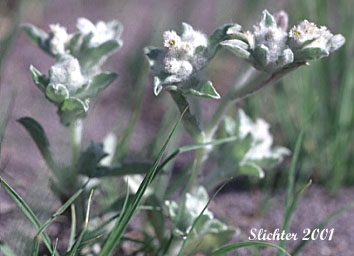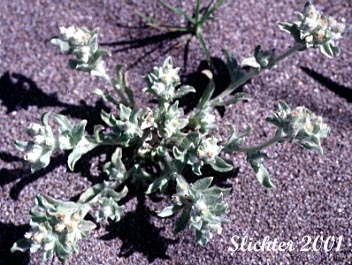 The photo at right shows the woolly flower heads of lowland cudweed clustered
at the tips of the stems and branches. Photographed next to the Deschutes River
at its mouth............September 3, 2000.
The photo at right shows the woolly flower heads of lowland cudweed clustered
at the tips of the stems and branches. Photographed next to the Deschutes River
at its mouth............September 3, 2000.
Lowland cudweed is an annual weed with a low, spreading growth. Its stems range in length from 3-15 cm long, although lengths to 30 cm may occur. The stems are mostly branched with alternating leaves. The herbage is covered with loose white hairs giving the plant the appearance of a smallish pearly everlasting. Individual leaves are often broadly oblanceolate or oblong in shape with entire margins. They range in length from 1-3.5 cm long and from 2-10 mm wide.
The numerous small flower heads are grouped in leafy bracted clusters at the ends of the stems. The involucral bracts are densely white woolly below and more brownish above with white tips. The involucral bracts range from 3-4 mm long.
Lowland cudweed may be found in low moist places such as along streams puddles, and in dried vernal pools. It may also be found as a considerable pest on moist cultivated lands. It is tolerant of alkali conditions.
Lowland cudweed may be found across much of Canada and in the western United States roughly from the Rocky Mts. west.
